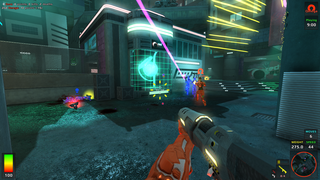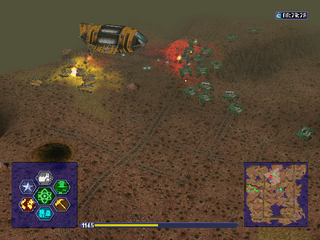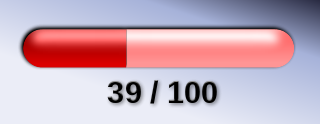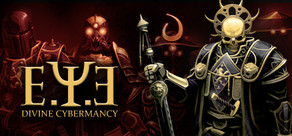
Deathmatch, also known as free-for-all, is a gameplay mode integrated into many shooter games, including first-person shooter (FPS), and real-time strategy (RTS) video games, where the goal is to kill the other players' characters as many times as possible. The deathmatch may end on a frag limit or a time limit, and the winner is the player that accumulated the greatest number of frags.

A tactical shooter is a sub-genre of first- and third-person shooters, associated with using strategy, planning, and tactics in gameplay, as well as the realistic simulations of ballistics, firearm mechanics, physics, stamina, and low time to kill. Dating back to strategy games from the late 1980s, the genre first rose to prominence in the late 1990s with the releases of several well-received tactical shooters. The popularity of the genre saw a decline in the late 2000s as fast-paced "arcade"-like action shooters rose to prominence, it has seen a revitalization since the mid-2010s with the successful releases of several modern tactical shooters.
An action game is a video game genre that emphasizes physical challenges, including hand–eye coordination and reaction time. The genre includes a large variety of sub-genres, such as fighting games, beat 'em ups, shooter games, rhythm games and platform games. Multiplayer online battle arena and some real-time strategy games are also considered action games.

Wonder Boy in Monster Land, known by its original arcade release as Wonder Boy: Monster Land, is a platform video game developed by Westone Bit Entertainment and released by Sega in Japanese arcades in 1987 and for the Master System in 1988, with a number of other home computer and console ports following. The game is the sequel to the 1986 game Wonder Boy and takes place eleven years after the events in the previous game. After enjoying over a decade of peace on Wonder Land following the defeat of the evil King by Tom-Tom, later bestowed the title "Wonder Boy", a fire-breathing dragon called the MEKA dragon appeared; he and his minions conquered Wonder Land, turning it into "Monster Land". The people, helpless due to their lack of fighting skill, call for Wonder Boy, now a teenager, to destroy the monsters and defeat the MEKA dragon. Players control Wonder Boy through twelve linear levels as he makes his way through Monster Land to find and defeat the MEKA dragon. Players earn gold by defeating enemies and buy weapons, armor, footwear, magic, and other items to help along the way.

Shooter video games or shooters are a subgenre of action video games where the focus is on the defeat of the character's enemies using ranged weapons given to the player. Usually these weapons are firearms or some other long-range weapons, and can be used in combination with other tools such as grenades for indirect offense, armor for additional defense, or accessories such as telescopic sights to modify the behavior of the weapons. A common resource found in many shooter games is ammunition, armor or health, or upgrades which augment the player character's weapons.

Replay value is the potential of a video game or other media products for continued play value after its first completion. Factors that can influence perceived replay value include the game's extra characters, secrets and alternate endings. The replay value of a game may also be based entirely on the individual's tastes. A player might enjoy repeating a game because of the music, graphics, gameplay or because of product loyalty. Dynamic environments, challenging AI, a wide variety of ways to accomplish tasks, and a rich array of assets could result in a high replay value.

Nitemare 3D is a horror-themed first-person shooter released by Gray Design Associates in 1994 for MS-DOS and Windows 3.x. There are three episodes with the first episode released as shareware and ten levels in each. The full release came on two 3½" floppy disks with a guide to the game's thirty levels. According to author David P. Gray, the game is the first pixelated Windows game to use the WinG interface. Along with WinDoom also from 1994, a similar first-person shooter, Bad Toys, was released for Windows 3.1 in 1995.
Game balance is a branch of game design with the intention of improving gameplay and user experience by balancing difficulty and fairness. Game balance consists of adjusting rewards, challenges, and/or elements of a game to create the intended player experience.
A cooperative video game, often abbreviated as co-op, is a video game that allows players to work together as teammates, usually against one or more non-player character opponents (PvE). Co-op games can be played locally using one or multiple input controllers or over a network via local area networks, wide area networks, or the Internet.

In video games, a level is any space available to the player during the course of completion of an objective. Video game levels generally have progressively increasing difficulty to appeal to players with different skill levels. Each level may present new concepts and challenges to keep a player's interest high.

A mini-map or minimap is a miniature map HUD element that is often placed at a screen corner in video games to help players in orienting themselves within the game world. They are often only a small portion of the screen and must be selective in what details they display. Elements included on mini-maps vary by video game genre, but most minimaps feature at least one or more of the following: the position of the player character, allied units, structures, enemies, objectives, and surrounding terrain.

Health is a video game or tabletop game quality that determines the maximum amount of damage or fatigue something takes before leaving the main game. In role-playing games, this typically takes the form of hit points (HP), a numerical attribute representing the health of a character or object. The game character can be a player character, a boss, or a mob. Health can also be attributed to destructible elements of the game environment or inanimate objects such as vehicles and their individual parts. In video games, health is often represented by visual elements such as a numerical fraction, a health bar or a series of small icons, though it may also be represented acoustically, such as through a character's heartbeat.

In video games, a quick time event (QTE) is a method of context-sensitive gameplay in which the player performs actions on the control device shortly after the appearance of an on-screen instruction/prompt. It allows for limited control of the game character during cut scenes or cinematic sequences in the game. Performing the wrong prompt, mistiming the action, or not performing any action at all results in the character's failure at their task, resulting in a death/failure animation and often an immediate game over or the loss of a life, with some games providing a lesser but significant penalty of sorts instead.
In computers, lag is delay (latency) between the action of the user (input) and the reaction of the server supporting the task, which has to be sent back to the client.
A variety of computer graphic techniques have been used to display video game content throughout the history of video games. The predominance of individual techniques have evolved over time, primarily due to hardware advances and restrictions such as the processing power of central or graphics processing units.

A first-person shooter (FPS) is a video game centered on gun fighting and other weapon-based combat seen from a first-person perspective, with the player experiencing the action directly through the eyes of the main character. This genre shares multiple common traits with other shooter games, and in turn falls under the action games category. Since the genre's inception, advanced 3D and pseudo-3D graphics have proven fundamental to allow a reasonable level of immersion in the game world, and this type of game helped pushing technology progressively further, challenging hardware developers worldwide to introduce numerous innovations in the field of graphics processing units. Multiplayer gaming has been an integral part of the experience, and became even more prominent with the diffusion of internet connectivity in recent years.

A loading screen is a screen shown by a computer program, very often a video game, while the program is loading or initializing.

E.Y.E: Divine Cybermancy is an action role-playing first-person shooter video game developed by Streum On Studio, and built using Valve's Source engine. It is a cyberpunk themed game based on an unreleased, private table-top role-playing game, A.V.A., developed by Streum On Studio in 1998. Streum-On-Studio have stated that it is "unlikely" that "A.V.A." will be sold publicly in the future. The game spent about two years in development before being released on Steam.
Since the origin of video games in the early 1970s, the video game industry, the players, and surrounding culture have spawned a wide range of technical and slang terms.














